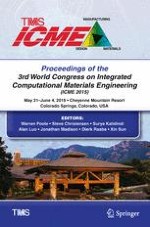2016 | Book
Proceedings of the 3rd World Congress on Integrated Computational Materials Engineering (ICME 2015)
Editors: Warren Poole, Steve Christensen, Surya R. Kalidindi, M.S., Ph.D., Alan Luo, Jonathan D. Madison, Ph.D., Dierk Raabe, Xin Sun
Publisher: Springer International Publishing
